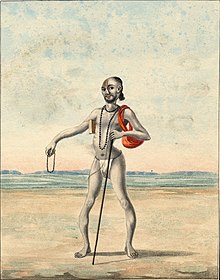Ashtavakra
| Aṣṭāvakra | |
|---|---|

Aṣṭāvakra was born with physical handicap and grows up into a celebrated sage in Hinduism. Above, a 19th-century painting.
|
|
| Religion | Hinduism |
| Philosophy | Monism (Vedanta) |
| Spouse | Suprabha |
| Religious career | |
| Guru | Aruni |
| Literary works | Ashtavakra Gita |
Ashtavakra (Sanskrit: अष्टावक्रः, IAST Aṣṭāvakra) is a revered Vedic sage in Hinduism. His name literally means "eight bends", reflecting the eight physical handicaps he was born with. His maternal grandfather was the Vedic sage Aruni, his parents were both vedic students at Aruni's school. Ashtavakra studied, became a sage and a celebrated character in the mythologies of the Hindu Epics and Puranas.
Ashtavakra is the author of the text Aṣṭāvakra Gītā, also known as Aṣṭāvakra Saṃhitā, in Hindu traditions. The text is a treatise on Brahman, Atman and monism (Advaita).
Little is known about the life or century in which Ashtavakra actually lived, except for the mythologies found in the major Indian Epics (the Ramayana and the Mahabharata) and the Puranas. The legends state that sage Aruni, mentioned in the Chāndogya Upaniṣad, ran a school (Āśrama) teaching the Vedas. Kahoḍa was one of his students, along with Aruni's daughter Sujata. Aruni's daughter married Kahoḍa. She got pregnant, and during her pregnancy, the developing baby heard the chanting of the Vedas and learnt the correct recitation. According to one version of the legends surrounding Ashtavakra, his father was once reciting the Vedas, but erred in correct intonation. The fetus corrected his father, the father got angry and cursed him. The curse caused him to be born crooked, with eight bends, which is what his name "Ashtavakra" means.
The different versions of the legends chronologically place him with Janaka, the ancient king of Videha.
Aṣṭāvakra is credited as the author of the Ashtavakra Gita (IAST: Aṣṭāvakra Gītā), which means "song of Ashtavakra". The text is also known as Aṣṭāvakra Saṃhitā. The Ashtavakra Gita examines the metaphysical nature of existence and the meaning of individual freedom, presenting its thesis that there is only one Supreme Reality (Brahman), the entirety of universe is oneness and manifestation of this reality, everything is interconnected, all Self (Atman, soul) are part of that one, and that individual freedom is not the end point but a given, a starting point, innate.
...
Wikipedia
